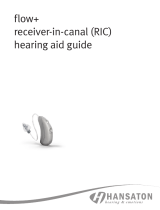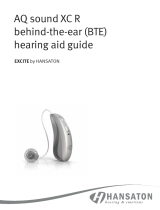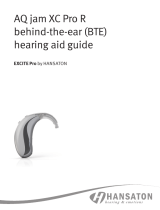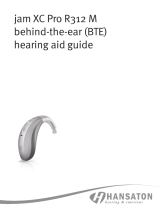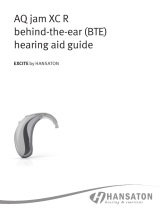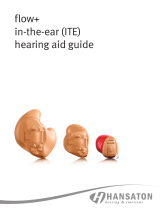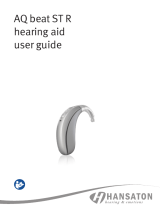Page is loading ...

sound XC R312
behind-the-ear (BTE)
hearing aid guide
EXCITE by HANSATON

Thank you
Thank you for choosing these hearing aids.
Hansaton is a hearing solution company that
believes people should feel really good about
the entire hearing experience, start to nish.
Our ingenious products, technologies, services
and programs oer a level of personalization
you can’t get anywhere else.
This user guide applies to the following models:
Year of introduction:
sound XC 9-R312
sound XC 7-R312
sound XC 5-R312
sound XC 3-R312

Your hearing aids
Hearing care professional: ____________________
___________________________________________
Telephone: _________________________________
Model: ____________________________________
Serial number: ______________________________
Battery size: 312
Warranty: __________________________________
Program 1 is for: ____________________________
Program 2 is for: ____________________________
Program 3 is for: ____________________________
Program 4 is for: ____________________________
Date of purchase: ____________________________

Quick reference
2 beeps every
30 minutes
Low battery warning Battery size
312
On/O
Multi-function button
On O Open

Your hearing aids at a glance ..................................................... 2
Warnings .................................................................................... 4
Tinnitus masker ........................................................................ 11
Putting your hearing aids on your ears......................................14
Turning your hearingaids onando ....................................... 16
Battery information ................................................................... 17
Operating instructions ............................................................. 20
Pairing your mobile phone with your
hearing aids ....................................................................... 23
Phone calls with a mobile phone ...................................... 25
Using your mobile phone with your
hearing aids .......................................................................26
Adjusting volume balance between mobile phone
calls and your environment ...............................................28
TV Connector ..................................................................... 29
Tinnitus masker ................................................................. 30
Flight mode ...............................................................................31
Connectivity overview .............................................................. 33
Caring for your hearing aids ..................................................... 34
Accessories ..............................................................................38
Troubleshooting guide ............................................................. 39
Warning to hearing aid dispensers (tocomplywith the
U.S. Food and Drug Administration (FDA) regulations) ........... 44
Information and explanation of symbols ................................. 46
Compliance information ...........................................................48
Your feedback .......................................................................... 52
Additional notes ....................................................................... 53
Table of contents

2
Your hearing aids at a glance
1 Wire – connects the speaker unit to your
hearingaids
2 Microphones – sound enters your hearing aids
through the microphones
3 Multi-function button – switches between
listening programs, changes the volume level,
and accepts or rejects mobile phone calls
depending on your customized tting
4 Battery door (on & o) – close the door to turn
on your hearing aids, partly open the door to
turn o your hearing aids. Opening the door all
the way gives you access to change the battery
5 Dome – holds the speaker unit in place in your
ear canal
6 Retention piece – helps prevent the dome and
speaker unit from moving out of the ear canal
7 Speaker unit – amplies the sound and sends it
directly into the ear canal
8 Custom mold – holds the hearing aids in place

3
3
2
2
3
4
5
1
7
6
8
1
2
2
3
3
4
sound XC R312 hearing aids

4
Warnings
The intended use of hearing aids is to
amplify and transmit sound to the ears and
hereby compensate for impaired hearing.
The hearing aids (specially programmed for
each hearing loss) must only be used by the
intended person. They should not be used
by any other person as they could damage
hearing.
Hearing aids should only be used as
directed by your physician or hearing care
professional.
Hearing aids will not restore normal hearing
and will not prevent or improve a hearing
impairment resulting from organic conditions.
Do not use your hearing aids in explosion
hazard areas.
Allergic reactions to hearing aids are unlikely.
However, if you experience itching, redness,
soreness, inflammation or a burning
sensation in or around your ears, inform your
hearing care professional and contact your
physician.

5
In the unlikely case that any parts remain in
the ear canals aer the removal of the
hearing aids, contact a physician immediately.
The following is only applicable for persons
with active implantable medical devices (i.e.
pacemakers, debrillators, etc.):
- Keep the wireless hearing aids at least 15
cm (6 inches) away from the active implant.
- If you experience any interference, do not
use the wireless hearing aids and contact
the manufacturer of the active implant.
Please note that interference can also
be caused by power lines, electrostatic
discharge, airport metal detectors etc.
Special medical or dental examination
including radiation described below, may
adversely aect the correct functioning of
your hearing aids. Remove and keep them
outside the examination room/area before
undergoing:
- Medical or dental examination with X-ray
(also CT scan).
- Medical examinations with MRI/NMRI scans,
generating magnetic elds.

6
- Hearing aids don’t need to be removed
when passing security gates (airports etc.).
If X-ray is used at all, it will be in very low
doses, and will not aect the hearing aids.
Special care should be exercised in wearing
hearing aids when maximum sound
pressure levels exceed 132 decibels. There
may be a risk of impairing your remaining
hearing. Speak with your hearing care
professional to ensure the maximum output
of your hearing aids is suitable for your
particular hearing loss.
Your hearing aids operate in the frequency
range of . GHz–.8 GHz. When flying
please check if flight operator requires
devices to be switched into flight mode.
Battery warning
Never leave hearing aids or batteries
where small children and pets can reach
them. Never put hearing aids or batteries
in your mouth. If a hearing aid or battery is
swallowed, call a physician immediately.

7
Note to hearing care professional
Domes should never be tted on clients with
perforated eardrums, exposed middle ear
cavities, or surgically altered ear canals. In
the case of such a condition, we recommend
to use a customized earmold.

8
Precautions
The use of hearing aids is only part of
hearing rehabilitation; auditory training and
lip reading instruction may be required as
well.
In most cases, infrequent use of hearing
aids does not provide full benet. Once you
have become accustomed to your hearing
aids, wear your hearing aids everyday all
day.
Your hearing aids use the most modern
components to provide the best possible
sound quality in every listening situation.
However, communication devices such
as digital mobile phones can create
interference (a buzzing sound) in hearing
aids. If you experience interference from a
mobile phone being used close by, you can
minimize this interference in a number of
ways. Switch your hearing aids to another
program, turn your head in a dierent
direction or locate the mobile phone and
move away from it.

9
Protect hearing aids from heat (never
leave near a window or in the car). Never
use a microwave or other heating devices
to dry your hearing aids (due to risk of
re or explosion). Ask your hearing care
professional about suitable drying methods.
The dome should be changed every three
months or when it becomes sti or brittle.
This is to prevent the dome from detaching
from the tube spout during insertion into or
removal from the ear.
Do not drop your hearing aids. Dropping
onto a hard surface can damage your
hearing aids.
Labeling
The serial number and year of manufacture are
located under the colored hearing aid marking.

10
Mobile phone compatibility rating
Some hearing aid users have reported a buzzing
sound in their hearing aids when they are using
mobile phones, indicating that the mobile
phone and hearing aids may not be compatible.
According to the ANSI C63.19 standard (ANSI
C63.19-2011 American National Standard
Methods of Measurement of Compatibility
Between Wireless Communications Devices and
Hearing Aids), the compatibility of particular
hearing aids and a mobile phone can be
predicted by adding the rating for the hearing
aid immunity to the rating for the mobile phone
emissions. For example, the sum of the hearing
aid rating of 4 (M4) and a telephone rating of 3
(M3) would result in a combined rating of . Any
combined rating that equals at least would
provide “normal use”; a combined rating of 6 or
greater would indicate “excellent performance.”
The immunity of these hearing aids is at least
M4. The equipment performance measurements,
categories and system classications are based
upon the best information available but cannot
guarantee that all users will be satised.

11
The performance of the individual hearing
aids may vary with individual mobile phones.
Therefore, please try these hearing aids with
your mobile phone or, if you are purchasing a
new phone, please be sure to try it with your
hearing aids prior to purchase. For additional
guidance, please ask your hearing care
professional for the booklet entitled “Hearing
aid compatibility with digital wireless mobile
p h o n e s .”

12
Tinnitus masker
Tinnitus masker uses broadband noise to
provide temporary relief of tinnitus.
Tinnitus masker warnings
The tinnitus masker is a broadband sound
generator. It provides a means of sound
enrichment therapy that can be used as
part of a personalized tinnitus management
program to provide temporary relief from
tinnitus.
The underlying principle of sound
enrichment is to provide supplementary
noise stimulation which can help defocus
your attention from your tinnitus and avoid
negative reactions. Sound enrichment,
coupled with instructional counseling, is an
established approach to managing tinnitus.
Air conduction hearing aids with the tinnitus
masker are to be tted by a hearing care
professional familiar with the diagnosis and
management of tinnitus.

13
Should you develop any side eects
while using the tinnitus masker, such as
headaches, nausea, dizziness or heart
palpitations or experience a decrease
in auditory function such as decreased
loudness tolerance, worsening of tinnitus, or
speech not as clear, you should discontinue
use of the device and seek medical
attention.
The volume of the tinnitus masker can be
set to a level which could lead to permanent
hearing damage when used for a prolonged
period of time. Should the tinnitus masker
be set to such a level in your hearing aids,
your hearing care professional will advise
you of the maximum amount of time per
day you should use the tinnitus masker. The
tinnitus masker should never be used at
uncomfortable levels.

14
Important information
The tinnitus masker generates sounds that are
used as part of your personalized temporary
tinnitus management program to provide relief
from tinnitus. It should always be used as
prescribed by a hearing care professional who
is familiar with the diagnosis and treatment of
tinnitus.
Good health practice requires that a person
reporting tinnitus have a medical evaluation by
a licensed ear physician before using a sound
generator. The purpose of such an evaluation
is to ensure that medically treatable conditions,
which may be causing tinnitus, are identied
and treated prior to using a sound generator.
The tinnitus masker is intended for adults 18
years of age or older who have both hearing
loss and tinnitus.

15
Putting your hearing aids on your ears
Your hearing aids will be color-coded with a
marking on the outside of the hearing aid:
red = right ear; blue = le ear.
Hearing aids with domes
1. Place the hearing aid over
the top of your ear.
2. Hold the wire where it
attaches to the dome and
gently push the dome into
your ear canal. The wire
should lie flush against
your head and not stick out.
3. If there is a retention piece,
place it in your ear so it
rests at the bottom of the
opening of your ear canal.
2.
3.
1.

16
Hearing aids with custom molds
1. Hold the custom mold
between your thumb and
index nger. The opening
should be pointing in
towards your ear canal with
the hearing aid resting
above your ear.
2. Carefully insert the custom
mold into your ear. The
mold should t into your
ear snugly and comfortably.
3. Place the hearing aid over
the top of your ear.
2.
3.
1.
/
